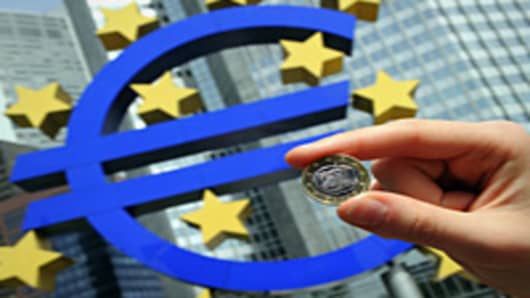The euro is hovering near multi-year lows against the U.S. dollar and the Japanese yen as a slew of negative news cements bearish sentiment towards the single currency, but analysts tell CNBC there are signs of resilience in the euro and a collapse is unlikely.
Ratings agency Moody’s late on Monday changed its outlook for Germany, the Netherlands and Luxembourg to negative from stable, while concerns grow that Spain may need a financial bailout. This has triggered talk that the currency could soon fall below the critical $1.20 level.
But Sean Callow, Senior Currency Strategist at Westpac says that so far the euro has withstood the pressure well.
“You would have thought that perhaps Moody’s placing Germany on a negative outlook would have been a potential trigger (for a move below $1.20),” Callow told CNBC Asia’s “Squawk Box”on Tuesday.
“But so far the euro has been pretty resilient so I think the euro bears might be a little disappointed at the moment. We do count ourselves among the euro bears but we probably need to see further weakness from Spain and inaction from the ECB (European Central Bank),” he added.
The euro fell to $1.2067 on Monday, its lowest level since June 2010, and hit a 12-year low against the yen at 94.23. A move below the psychological barrier of $1.20 could see the currency head towards the June 2010 low of $1.1875, say traders and analysts.
Emma Lawson, Senior Currency Strategist at National Australia Bank, agrees that while the euro is likely to weaken below the key $1.20 level, a rapid decline is unlikely.
“The market is very short but there is support, and we are more likely to see a slower move down from here,” said Lawson, adding that she expects the euro to recover and head up to $1.26 by the end of the current quarter – that is a gain of about 4 percent from current levels.
“We do expect the economy to stabilize and the market will get confidence in (euro zone) governments’ ability to control the crisis. We don’t rule out short-term bouts of risk aversion and weakness,” Lawson said.
Callum Henderson, Global Head of Forex Research at Standard Chartered, said he expected the euro to decline to $1.18 in the coming months, with a break under $1.20 a question of when and not if.
“The economic cycle is still pointing down. (But) the good news is that the euro is weakening and that should support the currency in the long term,” he said.
Analysts say the euro faces a test later on Tuesday when Spain’s government is scheduled to sell short-term debt at a time when investors are reluctant to buy bonds from governments in the euro zone’s periphery.
“The fact that short-term bills are on offer means the auction should go well. No one is expecting Spain to not pay 1, 3 month bills. The sale of longer-term bonds is the bigger test of confidence,” said Westpac’s Callow.
Yields on 10-year Spanish government bonds on Monday jumped to 7.6 percent, the highest since the birth of the single-currency zone, and well above the 7 percent level that triggered the rapid rise in borrowing costs that led to bailouts in other euro zone states.
By CNBC's Dhara Ranasinghe


